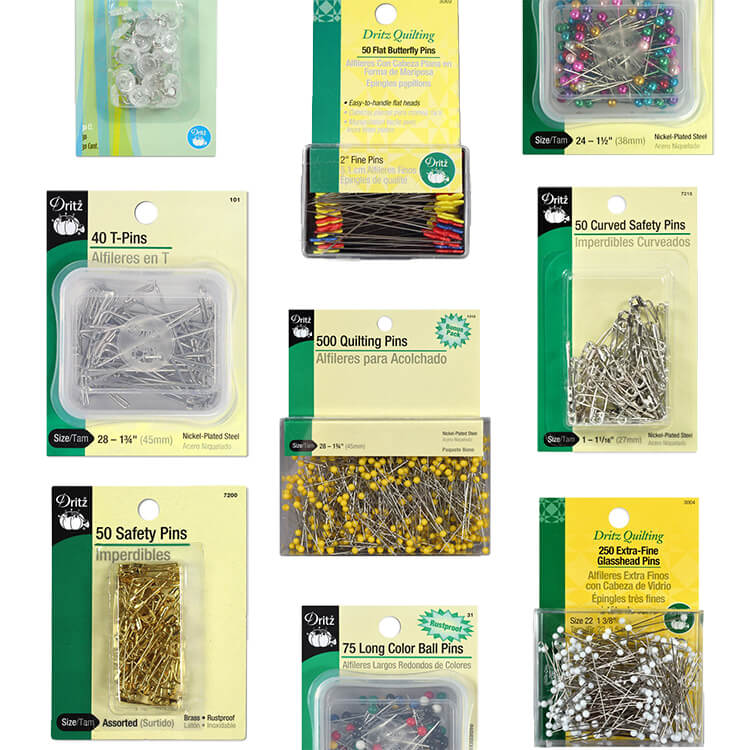Length, width, and content
There are all kinds of pin types, each available in a variety of lengths, widths, and content. The pin length and width you need depends on your project. If you’re working with thick fabrics or multiple layers, you want a longer, thicker pin. Smaller craft projects can use shorter and weaker pins. Most pins are between 1 and 3 inches in length (25 to 75 millimeters), and .4 and .8 millimeters in width.
The content of the pin doesn’t always matter, but you may want to take note of it. Metal content can affect the strength of the pin. Many pins are either nickel plated steel, stainless steel, or rustproof brass. If you’re allergic to some kinds of metal, content is very important. Also, if you work in an area exposed to a lot of humidity, you’ll probably want rustproof pins.
Straight pins
The most commonly used pins are straight pins. This includes a lot of categories like glass head, ballpoint, quilting, pearlized, and more. Straight pins are suitable for most sewing projects.
Glass head pins have glass heads (surprising, right?). This is important if you have a project that needs to be ironed between the pinning and sewing stages. For example, if you fold and pin a hem and need to iron before sewing, these pins are perfect.
Ballpoint pins aren’t quite as sharp at the tip. These pins are used for jersey fabrics and stretch knits. The slightly rounded tip of ballpoint pins slides in between the fibers instead of potentially ripping right through them.
Quilting pins are perhaps the most popular pins for a variety of projects. The shaft of these pins are thick and strong, and the heads are plastic. They’re suitable for holding together multiple layers, perfect for sewing quilt sandwiches. The heads are usually brightly colored so they’re easy to spot.
Pearlized pins are similar to quilting pins but not quite as thick and strong. They’re good for general use. You can find them in “petite” sizes that are thinner and shorter.
Flat-head pins (like these butterfly quilting pins) are good for hand work (like hand quilting) because the heads won’t get thread caught in them. They’re not good with thick or textured fabrics because they’re hard to see and can get lost.
Satin pins have a very thin shaft, so it slides easily through the fibers of finer fabrics like silk and satin. Most fabric fibers separate to make room for the pin and return to normal when the pin is taken out. Silk and satin fibers don’t do this, so they don’t take well to normal pins.
Dressmaker pins have a small, almost flat head and very sharp point to slide easily through fabric. They are often used for dressmaking but are fine for general craft use. These pins can also withstand heat from ironing.
Other pin types
Straight pins are popular for most sewing projects, but there are a few other kinds you may want to look into.
Even if you don’t really sew, you’ve probably come across safety pins before. Safety pins can be used to hold fabric and keep it from shifting during movement. This can come in handy if you’re making alterations to clothing or basting a quilt.
T-pins don’t quite fall into the “straight pin” category, but they might as well. The “head” is essentially a bent extension of the shaft. T-pins are sturdy enough to hold heavier fabrics and projects, like upholstery and outdoor fabric.
Twist pins have a small corkscrew instead of a straight shaft and a tack-like plastic head. Twist pins can be used to hold arm covers and slipcovers in place.
Now you know about a bunch of different kinds of pins. You may come across even more specialized varieties, but for most sewing projects, you won’t need to get anything super fancy. Also, there’s plenty of overlap. Just because it’s called a “quilting pin” doesn’t mean it can only be used for quilting. As a matter of fact, we use quilting pins in almost all of our DIY projects. Just consider length, width, content, and head type when choosing.





